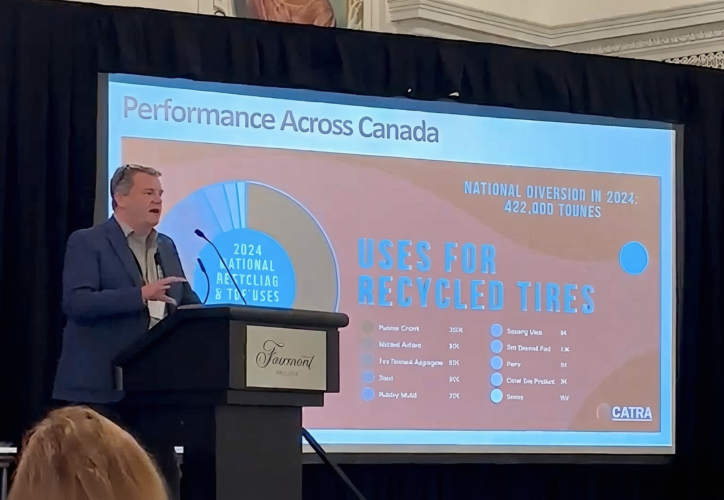Where Do My Old Tires Go? eTracks Has the Answer
Jurisdictions around the world have put laws on the books to incentivize tire recovery and recycling. But to enforce those rules, they need visibility into where tires come from and where they go. That’s where the eSustainable Recovery Platform comes in.
Originally published by TriplePundit
Around a billion tires are discarded globally each year. The world depends on tires for mobility, but without recovery and recycling programs, they can create major waste management problems. Their size and non-biodegradability means tires take up a lot of space in landfills, and if they’re illegally dumped, they can disrupt ecosystems, become a breeding ground for mosquitoes or even pose a fire hazard.
Given the environmental and public health implications, jurisdictions around the world have put laws on the books to incentivize tire recovery and recycling.
Among those legislative models is extended producer responsibility, or EPR, which requires producers to manage tire recovery and recycling. EPR laws have been around for decades in European countries and provinces across Canada, and the lessons learned along the way create a roadmap others can follow to ensure transparency and proper management that keeps tires out of the environment.
From the Wild West to best-in-class: Ontario’s lesson in traceability
Ontario, Canada’s largest province by population, first established EPR for tires back in 2018. The early days were a bit like the Wild West, recalls Steve Meldrum, CEO of eTracks, a not-for-profit established to help tire producers meet the needs of the new EPR laws.
Verified tire collection was not a strict requirement, leading to a glut of what Meldrum dubs “ghost tires.” Service providers could inflate tire recovery loads — and thus their paychecks — by driving over the same scale multiple times, and the collection depots that accept those loads often recorded exaggerated figures.
But it didn’t take long for Ontario leaders to spot the problem and introduce a stricter system requiring each individual producer and auto dealer to be responsible for the tires they bring into the province. Producers became responsible for recycling the tires they sold into the market a few years later at the end of their life.
This level of value chain scrutiny requires a complete tracking system that can definitively say where tires have been collected, the verified weights delivered to recycling depots, and the weight of recycled material sold onward for use in its next life.
That’s why eTracks developed the eSustainable Recovery Platform (eSRP). Rolled out in 2022, the tire tracking platform includes geotagging of every transaction, photos of tire pick-up and drop-off, and artificial intelligence capabilities that flag any weight discrepancies or inconsistencies with photographs.
“Ontario’s regulations are about as detailed as any regulation on the planet, so we figured if we build it for that, we can always turn things off for people who don’t need all the functions,” Meldrum says.
Dusting off the ledger book for the future of tire traceability
With a network of over 6,000 tire collection sites (dealerships, repair shops, transfer stations, etc.) in Ontario, eTracks can collect and trace tires across the province, which spans an area 1.5 times the size of Texas.
Haulers pick up the tires from collection sites, with QR code enabled documentation, and bring them to recycling depots. There, the hauler and recycling processor both electronically document the drop-off. The processor documents the amount of usable material retrieved after processing and inputs where the processed material has been sold as raw material for new products.
Though the industry hasn’t developed the ability to make a new tire from a scrap tire, popular end markets for tires include molded rubber products like athletic mats, sports flooring, flatbed truck liners, rubber-modified asphalt and artificial turf infill.
eTracks now tracks and traces about 13 million tires per year using the eSRP system. Producers that need to meet Ontario’s EPR requirements pay a fee to eTracks to manage the whole process, providing an auditable account of tire recovery, transportation, processing and onward sale of tire “crumbs.”
It’s a long way from the mostly paper record-keeping typical of the early days of EPR in the province. Tire stakeholders from mom-and-pop auto shops to small recyclers often used little more than ledgers, clipboards and dusty filing cabinets to keep tabs on tire transactions.
While some still try to meet EPR requirements this way, Meldrum says it simply doesn’t make sense for large companies with thousands of tons of tire recycling obligations to try to manage their systems on paper or in a spreadsheet.
“Paper management is untraceable, unauditable and really expensive,” Meldrum explains. “What do you do if you lose a clipboard that represents 20,000 tires? It’s just time consuming and completely unreliable.”
With the eTracks system, tires are tracked every step of the way. “We can take a rubber mat sold at Home Depot and more or less trace it back to where the used tires that made the product were collected,” Meldrum says.
EPR for tires takes hold in the United States
Building on success in Ontario, eTracks is now expanding its services into other Canadian provinces and gaining momentum in the United States.
Though eTracks’ platform can be used in jurisdictions that don’t have EPR, growing interest in EPR legislation among U.S. states could help pave the way for broader use. Connecticut passed the first U.S. tire EPR law in 2023, and Virginia and Vermont followed shortly after.
Conservationists, state lawmakers and local waste management authorities are welcoming the change. “For too long, the burden of unwanted tires not managed by the retail system, including illegally dumped tires, has fallen on local governments,” said Jennifer Heaton-Jones, executive director of the Housatonic Resources Recovery Authority serving western Connecticut, in a statement. “We now look forward to the support and partnership with manufacturers who will share the responsibility of end-of-life management of all scrap tires.”
Featured image credit: Pablo Merchán Montes/Unsplash
About This Content
This content was created in partnership with eTracks. TriplePundit maintains editorial independence and works with partners to create valuable content that aligns with our mission of solution-oriented journalism.





